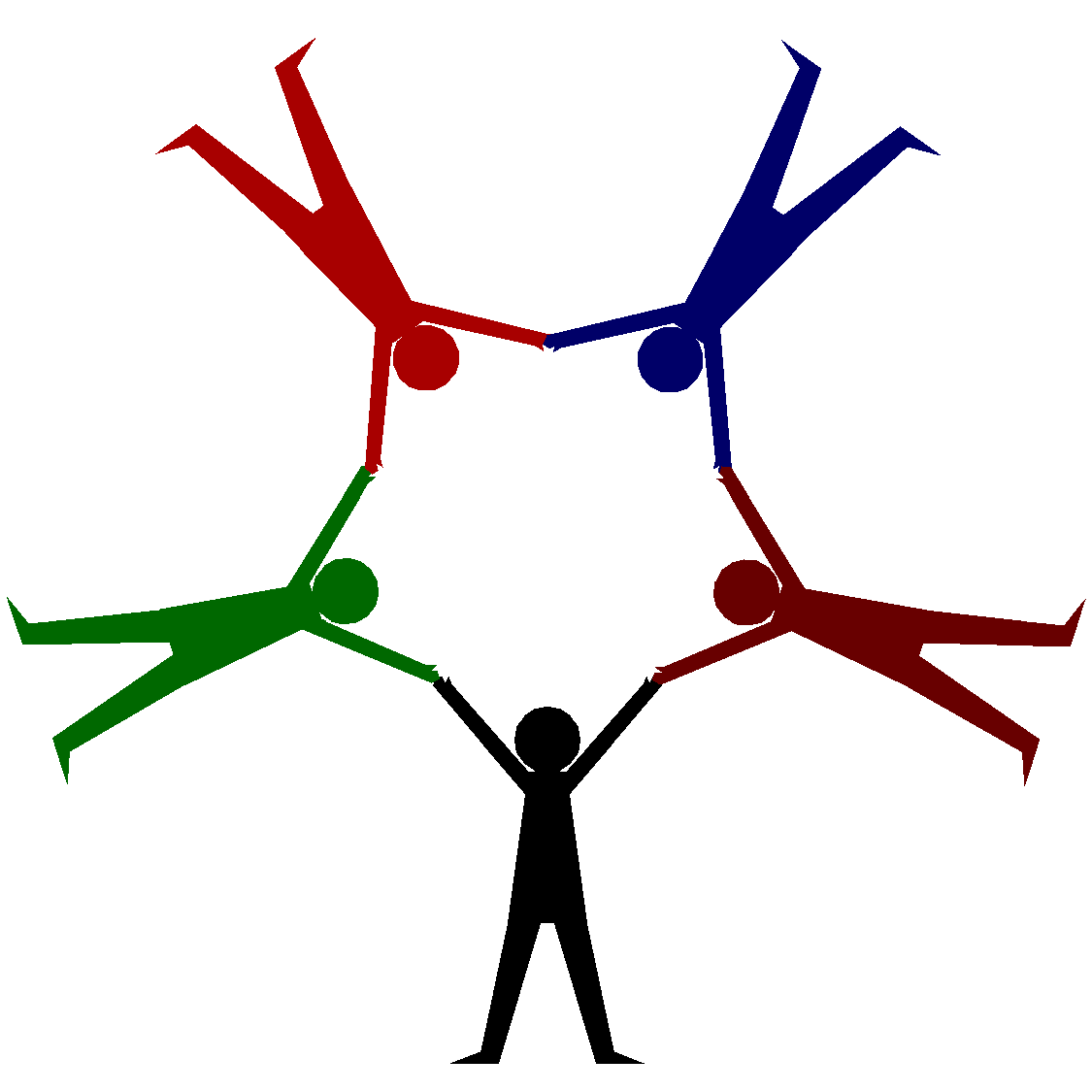Section 2.C: Democratic Group Process
In this Section:
The group process skills learned in a START course are oftentimes as useful as the knowledge acquired from the content. Techniques of democratic group process have evolved over the years to help groups achieve equal participation and control by everyone — and to assure that groups are not dominated by a few individuals. Ways have also been developed to help overcome superficial manipulation of facts and lack of personal involvement with the subject matter so that we can better integrate our intellectual learning and reflection with our social practices. In addressing these needs, we have been heavily influenced by Paolo Freire’s idea of conscientization as described in his book, Pedagogy of the Oppressed.
Below are some specific group process techniques that incorporate these ideas. Since they are different from the familiar teacher-student methods, they may seem awkward and artificial at first. After a few sessions of consciously trying them, however, groups usually become more comfortable with them.
For more suggestions on group process, check out Berit Lakey’s paper “Meeting Facilitation: The No-Magic Method” https://www.trainingforchange.org/training_tools/meeting-facilitation-the-no-magic-method/ and Randy Schutt’s papers on cooperative decision-making http://www.vernalproject.org/papers/Process.html, especially “Notes on Consensus Decision-Making”.
Seating Arrangement
To facilitate an egalitarian discussion, it is best for participants to arrange their chairs so that they sit in a rough semi-circle facing the wall chart. This ensures that participants can all see and hear each other and also that they are all facing forward towards their collective work as displayed on the wall chart.
Individual Responsibilities
With no leader in charge of running the course, its success is the responsibility of all the participants and is largely determined by the amount of participants’ collective input of time, energy, and concern. The more familiar each person is with the processes suggested in this study guide and the more responsibility is shared, the more the group will be able to function democratically.
Each participant should be prepared to do the following:
- Read through this study guide at the beginning and refer to it throughout the course.
- Be committed to reading a substantial amount of material (an average of about 50 pages — at 250 words/page) and giving a brief report on that reading to the group about every second session (though frequency depends on the size of the group). This commitment is central to participation in a START course.
- Take on the various group process roles described below on a rotating basis. [Also, perform these tasks whenever necessary even if not officially assigned that role.]
- Participate in group discussion without dominating or allowing others to dominate.
Group Process Roles and Tasks
To help the group stay on track while preventing anyone from dominating the discussion or decision-making, it is helpful to have a few members of the group take on special roles:
Convener
As described above, the convener is the person(s) who gets the START group started. That person recruits participants, arranges for the group to get together for the first meeting, takes ultimate responsibility for arranging time and place of meetings, helps arrange childcare, and provides the wall chart materials (at least for the first meeting). She/he may also take responsibility for facilitating the first few meetings (or arranging for an experienced person to facilitate). She/he may also participate in between-session planning meetings to assist the facilitator and assistant facilitator in developing agendas for meetings.
Facilitator
The facilitator’s task is to enable the smooth working of the group and help it achieve what it wants to achieve. The facilitator does not lead the group by telling it what to do, but serves the needs of the whole group and facilitates the process. The facilitator should:
- Plan: With the assistant facilitator, develop a meeting agenda based on the suggestions in this guide, the desires of the group, and feedback from the previous meeting’s evaluation. Before the beginning of the meeting, write this agenda on a large wall chart and post it on the meeting room wall.
- Initiate: Get the meeting started on time.
- Enforce Agreements: At the beginning of the meeting, review the agenda with the group (including time limits for each item), change the agenda in response to concerns and suggestions from the group, get the group to mutually consent to the amended agenda, and then, throughout the meeting, keep the group to its agreed agenda. Suggest when it is appropriate to move on to the next agenda item (usually based on time limits for items which the group has set for itself). If the group expresses a desire to change the agenda, help the group negotiate a new agreement, and then enforce this new agenda.
- Guide: Introduce each agenda item or prompt someone else to do this. Depending on the kind of agenda item, ask for reports, discussion, etc. Remind the group when they have strayed from the agenda, perhaps by asking if they want to return. Keep reports, discussion, and brainstorming sessions within agreed-upon time limits.
-
Encourage: Help everyone share in the discussion. Be sensitive to reserved people being cut off or intimidated by more extroverted folks. Encourage those who have not participated much to speak more and encourage those who talk a lot to listen more and speak less.
Also, encourage and help the other members of the group who have taken on roles to do their jobs.
It is also helpful if the facilitator can:
- Monitor: Be sensitive to the feelings of the group members. Note expressions of emotion, particular types of questions that indicate uneasiness, and the general mood — which may indicate that some change in process is called for.
- Reveal: Try to get important but unspoken frustrations, needs, fears, expectations, etc. out in the open so they can be dealt with directly. These “hidden agendas” are often an important source of failure and frustration in groups.
- Assist Discussions by actively using the 4 Ss:
-
- Summarize: Periodically, summarize briefly what has been said including any apparent disagreements, and check with the group that your summary is accurate by saying something like “Is that right?” or “Have I summarized this accurately?” This reassures people that they have been heard and their ideas are still part of the discussion.
- Sort: Suggest ways to separate disparate ideas and to place together similar ideas. Point out agreements and disagreements.
- Synthesize: Suggest ways that solutions or ideas can be melded together.
- Suggest Directions: Focus the discussion by suggesting a particular direction or order: first talk about this, then that, then the other.
- Mediate: When thorough communication is critical or when people seem unable to hear each other, ask people to repeat in their own words what they heard, and then check whether that person felt it was an accurate re-statement of what they had said. If not, the person can rephrase the idea until everyone understands. Telling the person “I think I hear you saying…” will usually obtain the desired result of clarification, and it grates a lot less than “You’re not being clear,” or “I don’t know what you are saying.”
Assistant Facilitator
The assistant facilitator helps the facilitator tend to group process by:
- Meeting (or talking by phone) with the facilitator beforehand to plan the meeting agenda.
- Monitoring how the meeting is going and making suggestions for change when appropriate.
- Taking over facilitation if the facilitator is unable to perform this task (because of illness, absence, or being overwhelmed during the meeting) or when the facilitator is carrying out another role such as presenting a report on a set of readings.
- Taking over another task (such as keeping track of time or recording) when the person designated to do that task is carrying out another role, such as presenting a report.
- If the group breaks into two subgroups for discussion, facilitating one of the groups.
Recorder
The recorder writes notes on the wall chart whenever it is useful to the group. This may include recording changes made to the agenda, important facts or ideas mentioned in reports, brainstormed ideas for action, ideas proposed in the evaluation section, etc.
Note that despite the best efforts of the recorder, it is sometimes difficult to recognize important ideas that should be recorded as they come up. So sometimes it is useful to have a separate piece of paper posted to the side that anyone can record thoughts on as she/he feels the need.
Timekeeper
The timekeeper helps the group move through the agenda by announcing when the agreed-upon time for each item has passed. It is often helpful for the timekeeper to give people a minute or two of warning, particularly during reports, so that they can use their remaining time well. The timekeeper should be seen as a reminder, not a dictator. When time has run out, the facilitator should help the group decide whether to allocate more time to the current agenda item or move on to the next one.
Vibes Watcher
 The vibes watcher is especially sensitive to the dynamics of group process, the emotional climate in the room, and outside distractions (noise, room temperature, and so on). She/he monitors body language, facial expressions, side conversations, and other signs to notice upsets, boredom, etc. If the group process gets off track, she/he points this out and suggests a remedy: perhaps a break, group stretching, a game, a moment of silence, encouragement for participants to say positive things about each other, adjustment of the thermostat, opening or closing the windows, etc.
The vibes watcher is especially sensitive to the dynamics of group process, the emotional climate in the room, and outside distractions (noise, room temperature, and so on). She/he monitors body language, facial expressions, side conversations, and other signs to notice upsets, boredom, etc. If the group process gets off track, she/he points this out and suggests a remedy: perhaps a break, group stretching, a game, a moment of silence, encouragement for participants to say positive things about each other, adjustment of the thermostat, opening or closing the windows, etc.
The vibes watcher should be sensitive to overt or subtle putdowns. It is crucial for the functioning of the group that everyone feels safe and supported. Learning and enjoyment usually stop dead when people feel insulted.
If the tone becomes offensive, the vibes watcher should intervene, preferably right at the moment, reminding the group that such a tone doesn’t foster learning or group building. The vibes watcher must use discretion to decide what level and kind of intervention is needed depending on the circumstances and the people involved.
Note that criticism of another person’s ideas is not a putdown. The whole point of a study group is to investigate and challenge ideas to determine if they make sense and can solve problems. Wrangling with ideas should be vigorously encouraged. However, the way that ideas are challenged is critical — some ways are humiliating and make people feel stupid and ashamed while other ways are enlightening and make people feel smarter and empowered. It is best if you can set up a situation in which people feel they are working together to honestly and seriously explore ideas — and their ramifications and consequences — rather than having an adversary situation in which perspectives (and, by implication, those that hold them) are attacked or ridiculed. When people disagree, gentle questioning is best. And sometimes people just have to realize and accept that they disagree — and then move on.
Roles Rotation
So that everyone can experience these various roles and learn how to do them well, and so that the responsibility for assisting the group is shared, it is best to have a different person take on each role at each session. To expedite signing up for roles, we recommend a simple way to do this: at every session, have one new person volunteer to be the Vibes Watcher for the next meeting. At the following meeting that person becomes the Timekeeper, then at the next meeting becomes the Recorder, then Assistant Facilitator, and finally Facilitator. This gives each person the chance to get a feel for what it is like to have some special concern for group process before taking on more responsibility (and attempting the more difficult tasks). At the first meeting, of course, various people will need to sign up for all five roles for both the first and second sessions.
You can download and print a form (pdf) (or in Microsoft Excel format) to help people sign up for these roles and remember what they have agreed to do over the course of the 24 weeks. Note that since there are 24 sessions, if your group has 10 participants, each person will eventually need to write her/his name on two separate rows on this list and four people will need to sign up on three rows. Also note that during every session, half of the 10 participants will have a specific role. If your group has fewer participants, then each participant will need to take on a correspondingly larger share of responsibility.
Personal Bonding
It is important to conduct meetings in an efficient, business-like manner so the time spent will feel worthwhile. But it is also important to encourage the human side of participants — personal interaction and bonding. Jokes, songs, and games can liven up a deadly serious group. Allocating some time to express support for a member who has experienced a hurt or loss allows caring to blossom. Potluck meals before some meetings or arranging group outings at other times (hikes, movies, restaurant meals, parties, etc.) can help the members of the group get to know each other and grow to like and care about one another.
Encourage these kinds of activities and it will make your study sessions go better and be more enjoyable. It will also encourage people to bond and uphold their commitments to one another.
 START
START 
